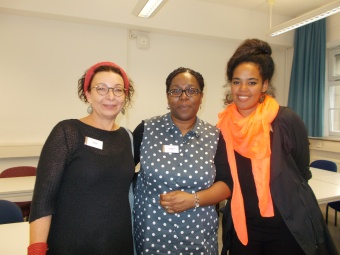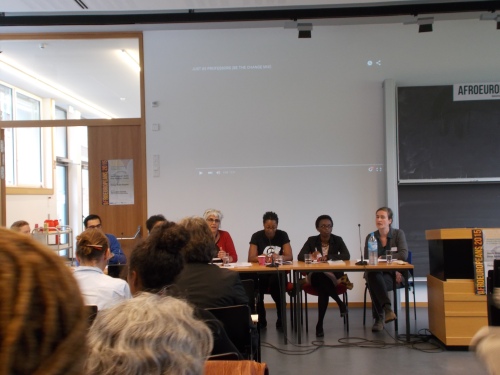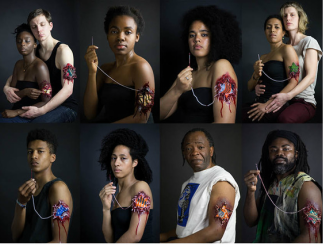Earlier in September I was pleased to present a conference paper at AfroEuropeans V: Black Cultures and Identities in Europe (University of Münster, 16-19 September 2015) – the fifth biennial network event exploring socio-political issues and spatialities relating to histories of migration, diaspora formation, economic interdependencies and cultural links between Africa and Europe.
My contribution formed part of a diverse programme of speeches, panel presentations, structured debates and artistic performances that enabled participants to engage in wide-ranging, interdisciplinary dialogues about past and present-day life experiences of Africans and Diasporans in Europe, with a particular focus on the role of activism within academia.

The opening keynote address by political scientist Jamie Schearer (a founding member of the European Network for People of African Descent (ENPAD)) set an optimistic tone for the conference by outlining the many positive and tangible ways ENPAD was initiating effective advocacy and awareness-raising campaigns, publishing educational resources and providing safe spaces for discussing the many complex and challenging issues of race and racism(s) faced by Africans in Europe. Some of the most successful projects recently undertaken in Amsterdam, London, Warsaw and Berlin were foregrounded – including the Black Heritage Amsterdam Tours, the “# Ferguson is Everywhere” campaign, and wider political lobbying related to issues of police violence, racial profiling, and inequalities within systems of justice. Fittingly, we were reminded of key figures in German history and political activism who have made significant contributions to discourses on challenging racism, xenophobia, stereotyping, anti-blackness, sexism and homophobia – not least the Afro-German poet and educationalist May Ayim (1960-1996), and the African-American writer and rights activist Audre Lorde (1934-1992).
Panel: Memory and Museums
My conference paper – “Black bodies, white privilege and the poetics of (mis-)representation” – formed part of a panel session on Memory and Museums, which also included filmed performance installations presented by the conceptual artist and curator Nathalie Mba Bikoro (University of Greenwich, UK), and a review of a collaborative exhibition project on “The African Presence in Finland” undertaken by sociologist Anna Rastas (University of Tampere, Finland) and displayed at the Finnish Labour Museum Werstas (Työväenmuseo Werstas).

Although my paper initially critiqued the controversial live performance installation ‘Exhibit B’ by South African theatre director Brett Bailey – a tour of 12 tableaux vivants staged in theatres around Europe, each showing black actors recreating scenes from 19th century human zoos and other colonial expositions – this only served as the counter-current for presenting alternative examples of effective and sensitive ways to curate difficult knowledge and exhibit anti-racist art, prefaced by the question: Can the subaltern black body only speak in Western arts spaces through the ventriloquized voice of white privilege?

Having been actively involved in the anti-Exhibit B boycott campaigns in London and Paris during 2014 (please see earlier blog posts, here), documentary photographs of the on-street demonstrations and interventions organised by the protest groups ‘Boycott the Human Zoo’ and ‘Collectif CONTRE-Exhibit B,’ were used to illustrate the paper. These were further contextualized using a montage of archival images about past human zoos, and then contrasted with a concluding selection of contemporary images of post-modern, anti-racist conceptual arts practice from the portfolios of renowned African Diasporan performance installationists and artist-curators such as Renée Cox, Coco Fusco and Fred Wilson.

London-based performance artist and curator Nathalie Mba Bikoro gave the second presentation, screening filmed extracts from two of her recent installation projects: “Future Monuments,” created to commemorate the victims of the Namibian genocide from the late-19th and early 20th centuries; and “Planting Present Tense,” a heart-rending and (literally) piercing performance in memory of African victims of genocide and other crimes against humanity.

In stark contrast to Brett Bailey’s corporeal absence from his tableaux vivants, a very striking and moving aspect of Nathalie Mba Bikoro’s artistic practice was the use of her own body as a living medium through which to communicate powerful counter-narratives about history and memory, cultural hybridity, diaspora(s), identities and alter-modernism. For example, during a very visceral clip from “Planting Present Tense” – performed at the Meinblau Project Room in Berlin earlier this year – Nathalie can be seen stitching a Star of David made from Dutch Wax patterned fabric into the skin of her bruised and bleeding upper left arm. Later, she is also shown carefully cutting a t-shirt embroidered with words from a letter dictated by her grandfather and sent to his family while he was imprisoned in a German labour camp in North Gabon during the war. The intricate symbolism within the piece reflected both personal and collective memories about the lasting traumas and legacies of colonialism and war – physically referenced in the fabric of these textiles, and also the ‘canvas’ of her skin.
Sociologist Anna Rastas concluded the panel by presenting a thought-provoking paper about the research methods underpinning her collaborative exhibition project, “The African Presence in Finland” (Finnish Labour Museum, Tampere, 29 April-8 November 2015). A key synergy between her commentary about co-production of curatorial narratives (incorporating the perspectives of c. 200 community participants) and my afore-mentioned critique of ‘Exhibit B’ was the importance we both placed on the need for meaningful consultations and active workshopping of ideas to ensure that any exhibition assemblages illustrating the realities of people’s diasporic, hybrid and transnational identities derived from genuine anti-racist collaborations. Unlike the muted and silenced portrayal of black people as stereotyped caricatures in Brett Bailey’s ‘Exhibit B‘, the Finnish project advocated and articulated rounded, plural, multi-vocal narratives of resilience – presented by artists, community activists, religious leaders and workers from all walks of life speaking for themselves.

Readings, Debates and Poetic Interludes
What transformed AfroEuropeans V from a conventional scholarly conference into a more meaningful dialogical space was, firstly, the diversity of the delegates – with as many community activists and practicing artists in the audience as there were academics and students. Secondly, the inclusion of ‘real world’ conversations about contemporary border-crossings, migrations, asylum and citizenship made the discussions purposeful and pertinent to current events. Lastly, the presentation of moving literary narratives alongside the topical political and scholarly debates allowed delegates the time and space to pause, assimilate and find ways to actively respond to the hard-hitting realities of ‘AfroEuropeanism’ in focus. With regard to the latter, Diran Adebayo’s personal reflections on family life, love and loss, sensitively read from his forthcoming memoir, “Random and Cricket,” provided a calming interlude within an otherwise fast-paced and tightly packed conference schedule.

Concluding remarks
The conference in Münster proved to be an extremely stimulating environment for engaging in important international discussions about the (often hidden) histories, life stories and cultural contributions of Africans and Diasporans in Europe. I am grateful to have been part of this forum in 2015, and look forward to further opportunities for sharing ideas, active engagement in political campaigns and scholarly collaborations within this emerging, interdisciplinary field of African European Studies.
Web links, for further information:
European Network for People of African Descent (ENPAD): http://bethechangenetwork.tumblr.com/
Nathalie Mba Bikoro – artist’s website: http://www.nbikoro.com
University of Münster, AfroEuropeans V: Black Cultures and Identities in Europe 2015 conference website: http://www.wwu.de/AFROEU2015/cfp.html

4 responses to “Memory and Museums at “AfroEuropeans V” (University of Münster, Germany)”
An excellent description of the conference sessions you attended and presented at.
LikeLike
It sounds like it was a very informative and interesting conference.
LikeLiked by 1 person
Yes it was. My co-presenter at that event in Germany, Dr Anna Rastas, is now convening the follow-up conference at the University of Tampere in Finland. I hope to Chair a different session about ‘Decolonising the Western Museum’ there too in July 2017 (see the cfp at https://museumgeographies.wordpress.com/2016/05/14/conference-on-african-diaspora-and-european-cultural-heritage-university-of-tampere-finland-6-8-july-2017/)
LikeLiked by 1 person
Hope it happens for you.
LikeLike